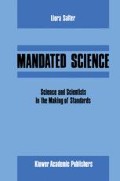Abstract
At least until recently, the product sold by the local hardware to protect wooden decks against deterioration probably contained pentachlorophenol. A warning on the cans says that pentachlorophenol is dangerous. No one seriously questions whether pentachlorophenol is dangerous. Like many household and industrial products in use today, its toxicity has been recognized for many years. Now pentachlorophenol has become controversial in Canada. A labour union is demanding a ban of the chemical, especially of its industrial uses. Some government officials predict this campaign will succeed, as pentachlorophenol was banned in Sweden and Japan. These same officials maintain that the chemical can be used safely, and that there is no need for a ban. They believe that a ban would reflect pentachlorophenol’s status as a political chemical.
Access this chapter
Tax calculation will be finalised at checkout
Purchases are for personal use only
Preview
Unable to display preview. Download preview PDF.
Notes
K. R. Rao, (ed.), Pentachlorophenol: Chemistry, Pharmacology and Environmental Toxicology, (New York: Plenum Press, 1978), p. 394.
American Conference of Governmental Industrial Hygienists — Committee on Threshold Limit Values, Documentation of Threshold Limit Values, (Fourth Edition), (Cincinnati: ACGIH, 1981), p. 323.
See: Statement of Douglas M. Wilson on “The Deleterious Effects of Chlorophenols to Fish”, Regina vs. Cloverdale Paint and Chemicals Ltd., August, 1984.
Daniel P. Cirelli, Project Manager, U.S. Environmental Protection Agency, Position Document 1, p. 13.
Theodor D. Sterling, Larry D. Stoffman, David A. Sterling and Gabor Mate, “Health Effects of Chlorophenol Wood Preservatives on Sawmill Workers,” International Journal of Health Services, Vol. 12, No. 4, (1982), pp. 559–571.
See for example: Donald A. Enarson, Moira Chan-Yeung, Valerie Embree, Robert Wang, Michael Schulzer, Occupational Exposure to Chlorophenates: Renal, Heptic and other Health Effects, a report from the Occupational Diseases Research Unit, Respiratory Division, Vancouver General Hospital, Department of Medicine, University of British Columbia, (not dated).
Union letter dated July 21, 1983, from: J. J. Munro, President, IWA to: K. J. Bennett, Forest Labour Relations Council.
P. A. Jones, Chlorophenols and their Impurities in the Canadian Environment, (EPS 3-EC-81–2), March, 1981.
Ibid. p. xxxiii
See: M. F. Mitchell, H. A. McLeod and J. R. Roberts, Polychlorinated Dibenzofurans: Criteria for their Effects on Humans and the Environment, (NRCC No. 22846 of the Environmental Secretariat), 1984, p. 26.
NRCC Associate Committee on Scientific Criteria for Environmental Quality, Polychlorinated Dibenzo-p-Dioxins: Criteria for their Effects on Man and his Environment, (NRCC No. 18574 of the Environmental Secretariat), 1981, p. 16.
Health and Welfare Canada, Environment Canada, Report of the Joint Health and Welfare Canada/Environment Canada Expert Advisory Committee on Dioxins, November, 1983.
See: Interdepartmental Committee on Toxic Chemicals, Environment Canada, Dioxins in Canada: The Federal Approach, December, 1983.
See especially: O. Axelson and L. Sundell, “Herbicide Exposure, Mortality and Tumor Incidence. An Epidemiological Investigation on Swedish Railroad Workers”, Scan. J. Work, Environment, Health, 11, (1974), pp. 21–8.
L. Hardell, and A. Sandstrom, “Case Control Study: Soft-tissue Sarcomas and Exposure to Phenoxyacetic Acids or Chlporophenols”, British Journal of Cancer, 39, (1979), pp. 711–17
O. Axelson, L. Sundell, K. Anderson, C. Edling, C. Hogstedt, and H. Kling, “Herbicide Exposure and Tumor Mortality: An Updated Epidemiological Investigationon Swedish Railroad Workers”, Scan. J. of Work, Environment & Health, 6, (1980), pp. 73–79
L. Hardell, M. Eriksson, P. Lenner, and E. Lundgren, “Malignant Lymphoma and Exposure to Chemicals Especially organic Solvents, Chlorophenols and Phenoxy Acids: A Case-Control Study”, British Journal of Cancer, 43, (1981), pp. 169–76
L. Hardell, “Relation of Soft-tissue Sarcoma, Malignant Lymphoma and Colon Cancer to Phenoxy Acids, Chlorophenols and other Agents”, Scan. J. of Work, Environment & Health, 7, (1981), pp. 119–130
M. Eriksson, L. Hardell, N. O. Berg, T. Moller, and O. Axelson, “Soft-tissue Sarcomas and Exposure to Chemical Substances: A Case-Referent Study”, British Journal of Industrial Medicine, 38, (1981), pp. 27–33
L. Hardell, and N. O. Bengtsson, “Epidemiological Study of Socio-economic Factors and Clinical Findings in Hodgkin’s Disease and Reanalysis of Previous Data Regarding Chemical Exposure”, British Journal of Cancer, 48, (1983), pp. 217–225.
D. Coggon, and E. D. Acheson, “Do Phenoxy Herbicides Cause Cancer in Man?”, Lancet, May 8, 1982, pp. 1057–59; C. M. Bishop and A. H. Jones., “Non-Hodgkin’s Lymphoma of the Scalp in Workers Exposed to Dioxins,” Lancet, August 15, 1981, p. 369; P. A. Honchar and W. E. Halperin, “2,4,5-T, Trichlorophenol and Soft-tissue Sarcoma”, Lancet, i, (1981), pp. 268–269
C. Edling and S. Granstam, “Causes of Death among Lumberjacks — A Pilot Study”, Journal of Occupational Medicine, 22, (1980), pp. 403–406
J..P. Seiler, “The Genetic Toxicology of Phenoxy Acids other than 2,4,5-T”, Mutat Res, 55, (1978), pp. 197–226.
USA — EPA hearings on 2,4,5-T and Silvex; 1980. PD 1 published, 43 FR 48443, 10/18/78: PD 2/3 (wood use only) completed and Notice of Determination published in 46 FR 13020, 2/19/81, comment period closed PD 4, 5/13/83.
Correspondence collected by a participant in the debate was made available to us.
Royal Commission on the Use and Effects of Chemical Agents on Australian Personnel in Vietnam, Final Report, July, 1985, p. viii-112.
Ibid.,p.viii–116.
B. K. Armstrong, “Storm in a Cup of 2,4,5-T”, The Medical Journal of Australia, Vol. 144, March 17,1986, pp. 284–85.
See: Health and Welfare Canada, Environment Canada, Report of the Joint Health and Welfare CanadalEnvironment Canada Expert Advisory Committee on Dioxins, November, 1983.
Also see: E. Levy, “The Swedish Studies of Pesticide Exposure and Cancer: A Case Study of Disciplinary and Mandated Science”, Alternatives, forthcoming.
Rights and permissions
Copyright information
© 1988 Kluwer Academic Publishers
About this chapter
Cite this chapter
Levy, E. (1988). An Economic Poison Case Study Four: Pentachlorophenol. In: Mandated Science. Environmental Ethics and Science Policy, vol 1. Springer, Dordrecht. https://doi.org/10.1007/978-94-009-2711-7_6
Download citation
DOI: https://doi.org/10.1007/978-94-009-2711-7_6
Publisher Name: Springer, Dordrecht
Print ISBN: 978-1-55608-077-7
Online ISBN: 978-94-009-2711-7
eBook Packages: Springer Book Archive

